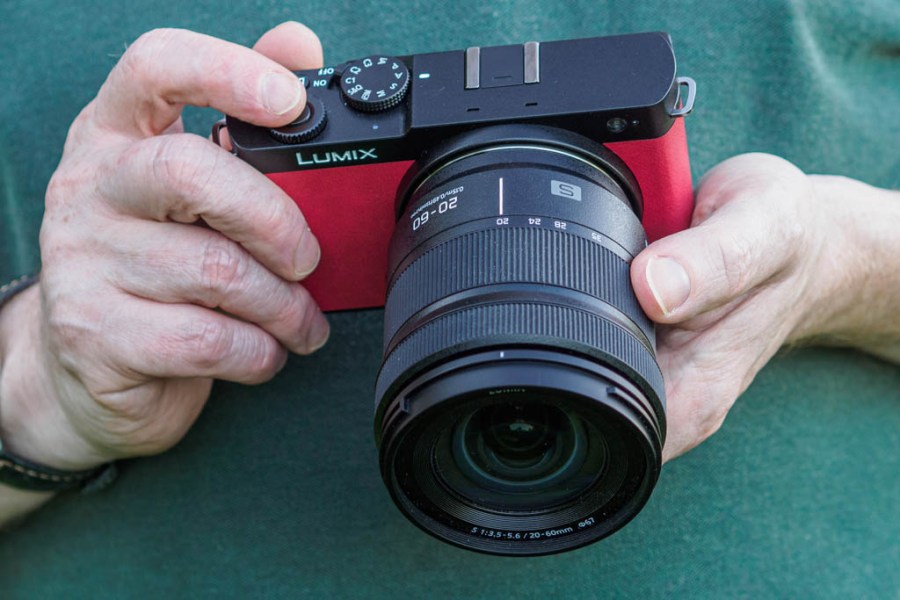We’ve just seen the arrival of the latest Lumix camera, the Panasonic S9. This is a full-frame L-mount model that takes many of the features of the SLR-shaped Lumix S5 II and squeezes them into a much smaller body. According to Panasonic’s press release, it’s supposed to be “a stylish companion for content creators on the go”, and it comes in four attractive colours.
I must admit, when I first saw the Lumix S9, I was completely smitten. It’s a fine-looking camera that has a real ‘Leica-like’ look to it; in fact, it could almost pass for an interchangeable-lens version of the fabulous Leica Q3. Panasonic has dabbled in this flat-bodied, two-tone design before, and if your memory goes back far enough, you may well be reminded of the Micro Four Thirds Lumix GM1 and GM5. These were lovely little pocket-sized cameras that still have a cult following today.
But here’s the thing – appearances can be deceptive. While the S9 looks like it should be the kind of small, unobtrusive camera that stills photographers like to use for street shooting, it simply isn’t that at all. Instead, it’s an entirely different beast that’s designed much more for video, and travel vlogging in particular. Indeed, its companion ‘Lumix Lab’ smartphone app is all about editing and sharing videos, with a huge emphasis on using LUTs to apply different colour looks.
Design compromises
If you like the look of the Panasonic S9 and are contemplating buying it, you really do need to understand the design decisions the firm has made with this camera. Firstly, it has no viewfinder, meaning you have to compose using its fully articulated rear screen instead. Secondly, it does without a mechanical shutter, so for stills photography you’re entirely reliant on the sensor’s electronic shutter. One knock-on effect of this is that if you want to shoot with an add-on flash, that’s just too bad: you can’t.
Now you can get away without a mechanical shutter if you have an ultra-fast stacked CMOS sensor, like the Nikon Z 8 or Sony Alpha A9 III. But the Panasonic S9 doesn’t. To be fair, much of the time there’ll be no image-quality penalty at all. But under certain shooting conditions it’ll be prone to nasty artefacts, for example distortion of fast-moving subjects, and colour banding under artificial light.
This clearly isn’t a camera for high-end video shooters, either. There’s no headphone socket for monitoring audio, and only a Micro-HDMI port for outputting video to a monitor or recorder. These connectors are horrible compared to full-size HDMI – they constantly fall out or break. This means videographers will be much better off with the S5II (or the even more video-specialist S5IIX).
Lens choices
Even for its target audience of travel vloggers, I can see causes for concern. Most importantly, a small camera like this will always work best with compact lenses. Panasonic’s own product shots concentrate on showing the S9 with either the super-slim 26mm prime that was announced alongside, or an 18-40mm kit zoom.

Unfortunately, though, that 26mm pancake is manual focus only and has a fixed f/8 aperture. It’s really not going to get the most from the camera. And while the 18-40mm looks like it’ll be a great match, it doesn’t actually exist yet – Panasonic just tells us that it’s coming some time in 2024. Probably the best option at the moment would be Sigma’s small i-series lenses, such as the 45mm F2.8 DG DN.
For now, Panasonic is offering the S9 in kits with its existing Lumix S 20-60mm F3.5-5.6 and 28-200mm F4-6.7 zooms. Despite being small compared to other manufacturers’ kit zooms, these still end up feeling unbalanced on the petite body. This is exacerbated by the lack of any handgrip – you’ll almost certainly want to acquire the add-on grip from SmallRig.

However, I think the biggest concern for any potential user will lie with the screen. After shooting with the camera on a couple of fine early summer days, I have to report that it’s just not bright enough to see properly in sunlight. That’s likely to be a real problem, no matter what kind of shooting you do.
Really… it’s not a Leica
Despite all this, I’m sure there are some photographers who’d really like to give the Panasonic S9 a try. And to be fair, I suspect that when the 18-40mm kit zoom finally appears, the camera will make a whole lot more sense. Just don’t be fooled into thinking you’ll be getting a Leica-like street camera on the cheap. Instead, it’s a camera for vloggers that’s just dressed up to resemble a vintage rangefinder.
Related content:
- Panasonic Lumix S9 first-look review: a travel-friendly hybrid camera?
- Panasonic announces Lumix S 26mm F8 pancake prime
- Compact Panasonic Lumix S 18-40mm F4.5-6.3 kit zoom coming
Follow AP on Facebook, Twitter, Instagram, YouTube and TikTok.







